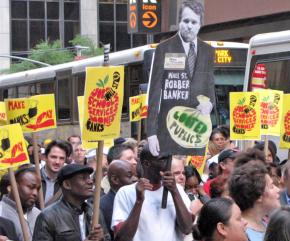Will NYC labor stand up against the cuts?
report from New York City on the latest mobilization against Michael Bloomberg's budget-cutting attack.
TENS OF thousands of New York City workers rallied at City Hall in the drizzling rain on June 14 to oppose Mayor Michael Bloomberg's threats to lay off workers, slash pensions and cut essential services.
Class anger at Bloomberg ran high among the crowd. "Bloomberg wants us to feel expendable, to make us feel like the contribution we make isn't important," said Liza Campbell, a high school teacher and organizer of the New Teacher Underground project. "This way, we don't feel like we deserve a decent salary, benefits, a pension. Once we internalize this, it becomes leverage to erode everything we've worked for in our union."
Another marcher said, "All [Bloomberg's] done is privatize and put his friends in cushy jobs."
The rally was organized by AFSCME District Council 37, the largest union of city workers, with 125,000 members. While DC 37 members made up a large majority of the enthusiastic crowd, they were joined by Teamsters, day care workers and transit workers, as well as thousands of members of the United Federation of Teachers, who marched across the Brooklyn Bridge to join the rally.

After the rally, about 100 activists started a "Bloombergville" encampment opposite City Hall Park--modeled on the Walkerville tent city in Madison and the occupation of public squares in Spain and other European countries. The activists pledged to stay through the night and try to continue the protest until the budget cuts are defeated.
THE MANY union leaders who spoke at the rally were long on militant rhetoric, but short on concrete plans to stop the layoffs and cuts. Many urged the crowd to lobby the New York City Council. Raglan George, executive director of AFSCME DC 1707, said that Bloomberg should be recalled. Unfortunately, New York City has no provisions for a recall.
The featured speaker was Lee Saunders, the International secretary-treasurer of AFSCME. He led the crowd in chants of "Tell me what democracy look like--This is what democracy looks like."
Saunders castigated Bloomberg for "talking about taking away our pensions and our jobs," and declared that "We say, 'Hell no.'" He urged the crowd to "Stand up and make our voices heard" and "Keep on rallying, keep on marching." But AFSCME hasn't called another rally, and Saunders didn't say what unions should do if the marches and rallies don't stop the layoffs and cuts.
The labor leaders who spoke likewise didn't say if the unions are going to hold firm against any cuts, or look to negotiate a compromise. Earlier in the day, a top union official in the Municipal Labor Committee announced a proposal to avoid layoffs by letting the city raid the unions' Health Insurance Stabilization Fund, which is meant to protect city workers from the brunt of health care cost increases.
But there's no reason to make any concessions. Bloomberg can avoid any layoffs or cuts by tapping into the city's $3 billion surplus or raising taxes on himself and the rest of the city's obscenely wealthy.
In a speech at the Bloombergville encampment later in the evening, New York City Council member Charles Barron predicted that city officials would "discover" extra funds, reduce the scale of the layoffs and cuts--and declare that this was a victory. But, Barron said, the city could find enough money to avoid any cuts at all. Barron also pointed out that the City Council, which is filled with progressive Latino, Black and Asian representatives, could simply reject Bloomberg's cuts by voting no on the budget.
Unfortunately, many people at the rally weren't sure about what to do next. A number of them gave voice to the sentiment that we need to keep mobilizing, but without any certainty that others would fight alongside them.
The activists who started Bloombergville on June 14 hope to give these workers a place to go in the coming days by providing a focal point for protest and political discussion. "The big question is what's going to happen tomorrow," said encampment organizer Doug Singsen. "There was some media coverage today, and we're hitting social media as hard as we can. There are two protests happening tomorrow--another union rally and a protest to strengthen rent laws. We're going to relate to both of them."
Hours before the June 14 rally began, DC 37 announced it would not endorse Bloombergville--and the Coalition for the Homeless, apparently after receiving some pressure, rescinded its offer to allow overnight protesters access to their nearby office for restroom and storage use. This distancing from the Bloombergville protest shows that many unions and non-profits remain focused on a strategy of negotiation and compromise, rather than confrontation.
But across Great Recession America, compromise and negotiation are clearly not working with politicians who are openly committed to protecting the profits and tax breaks of the wealthy, even at the expense of savage cuts for everybody else.
Only protests that hinder business as usual in New York City will stop Bloomberg's cuts. The rally today was a good start for an all-out campaign against the cuts, but it will take a lot more to actually save city workers' jobs and pensions.


